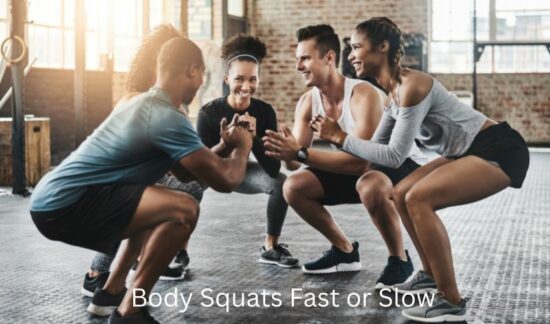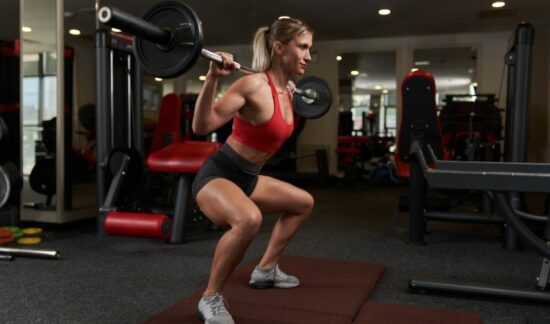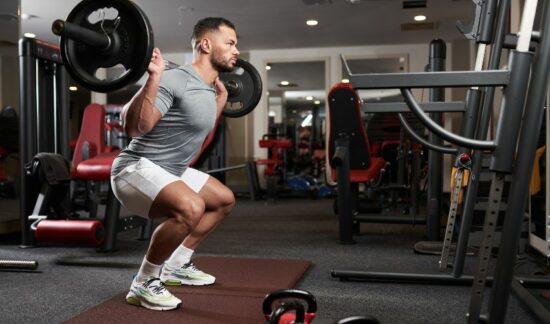Squats are, without a doubt, one of the most effective workouts that have ever been developed. I think we can all agree on that.
There are very few workouts that are superior to others in terms of building strength, muscle, power, and burning fat.
Squats are one of the fundamental human movement patterns, and this is true regardless of whether or not you are carrying weights on your back.
Squats, for this reason, are also an exceptionally significant form of physical activity.
So, what kind of tempo should you use when practicing squats?

Let’s find out.
What Exactly Are Squats, And Which Muscles Are Being Targeted By Them?
Squats are a form of exercise in which the participant lowers their body into a sitting position before pushing themselves back up to their feet.
They focus largely on the buttocks, thighs, and hips, but they also engage other muscles throughout the body, such as the core, the back, and the calves.
Squats can be performed either by using one’s own body weight as a form of resistance or by adding additional weight in the form of barbells or dumbbells to improve the level of difficulty and intensity of the exercise.
Building strength, enhancing athletic performance, and producing a toned lower body are all goals that may be accomplished by performing squats, which is why they are such a popular workout among fitness enthusiasts and athletes.
When Performing Squats, How Many Calories Can Burn?
When performing squats, the quantity of calories you burn is dependent on a variety of factors, including your current fitness level, your body weight, the intensity and length of the exercise, and how long you perform it for. By performing squats for ten minutes, an individual who weighs around 70 kilograms (154 pounds) can burn between 100 and 150 calories on average. But, this might change quite a bit depending on the person, so keep that in mind.
Squats are a good workout for burning calories and growing muscle because they engage many muscle groups, including the quadriceps, glutes, and core muscles. In general, squats are considered to be an excellent exercise. It is essential to practice squats with correct technique and progressively increase the intensity and duration of your workout over time if you want to get the most bang for your calorie-burning buck out of this exercise.
Should You Do Squats Quickly Or Slowly?
The traditional squat technique consists of a fast concentric phase and a gradual eccentric phase (the descending phase) (coming back up). It should take you about three to four seconds to lower yourself, and about one second to lift yourself back up to the starting position. Squats performed at a slower pace, on the other hand, will increase time under strain, which may result in improved hypertrophic growth. On the other hand, performing squats at a faster pace might help you build both speed and power.
1. The Conventional Method Of Squatting
Regarding the “conventional” squat, I have always adhered to the principle of doing a slow eccentric period followed by a powerful concentric phase.
The descent into a full squat usually takes me about four seconds, after which I shoot back up as quickly as I can.
If I execute a set of six to twelve squats in this manner, I will have very much covered all of the training protocols.
The gradual descent phase is beneficial for the development of muscle tissue and tendon strength, as well as for the strengthening of the central nervous system.
In addition, the raising phase, which is performed at a rapid rate, will assist in building power in my lower body.
In light of the aforementioned information, I am able to alter the tempo of the entire squat in order to target a specific type of training program more than the others.
2. Do Squats At A Rapid Rate To Improve Your Power And Speed

I would think that quite a few of you are interested in squatting for either speed or power.
You might participate in a certain activity that requires a lot of movement, such as jumping, running, kicking, etc.
Regardless of the sport you play, leg strength remains a very vital component.
Having speed and legs that can force you through when you’re tired is essential, but it’s not enough on its own.
In most cases, this would be the only occasion on which I would perform a rapid squat workout.
While increasing your strength or muscle mass, you should utilize a weight that is slightly less than what you are accustomed to using.
In addition, rather than setting a goal for a particular number of repetitions, I would focus more on squatting for the allotted amount of time.
So, this may entail a short, intense burst of squats performed at a rapid rate for twenty to thirty seconds.
I suppose that you could also perform this speed and power workout as a conditioning routine if you really wanted to.
Maybe following the Tabata protocol of “work” for 20 seconds followed by “rest” for 10 seconds, for a total of 4 minutes.
No matter what you choose, you have the ability to execute squats at a significantly quicker pace.
It is possible that this will have less of an impact in terms of strength and hypertrophy, but it is perfect for enhancing power and speed.
Having said all of that, if you are going to execute squats at a quick pace, there are a few things you should keep in mind.
3. Watch Out For Your Arthritic Joints
When you execute quick squats, one thing you do need to be cautious of is the stress that is exerted on your joints. You should take this into consideration.
This is especially the case for the more diminutive joints of the leg, such as the knees and the ankles.
By performing squats at a faster tempo, there is a greater likelihood of falling into the squat.
During the eccentric phase of the movement, there is almost no meaningful control, and it is possible to practically tumble into the bottom of the movement.
This “drop” approach will exert an enormous amount of stress on the knees, which will of course increase the risk of sustaining an injury.
You might make the same argument regarding the pressure that is put on the ankles as well.
Also, if you are lifting with a weighted barbell on your back, you will be putting a significant amount of strain on your lower back.
Overall, if you just drop into a squat without warming up, you’re asking for trouble in the form of a potential injury that’s just waiting to happen.
It is not my intention to imply that you can perform squats with a barbell at a rapid pace; however, you do need to make sure that you are lowering yourself with complete control.
4. Instead, Perform Explosive Variations Of The Squat.

There are many more effective variations of the squat that you can perform if your goal is to increase your speed or power.
It is far more appealing to me to use my own bodyweight to complete exercises like box jumps and jump squats.
Jump squats can be performed with any type of barbell, trap bar, dumbbells, or kettlebells.
In my opinion, any weighted variation of an explosive squat should be performed with fewer reps each set and a significant amount of recovery in between the sets.
Depending on the kind of squat you do, I would recommend keeping your rep range between 3 and 6, and giving yourself anywhere from 2 to 5 minutes of recovery in between each session.
In addition, given that the emphasis is placed more on speed and power, you will need to drastically cut down on the amount of weight that you are utilizing.
The intensity of the movement is going to be the focus of this particular workout.
You can still look at progressive overload over the course of a period of time, just like you would with any other form of exercise or training routine.
Hence, start out low, maintain an energetic movement, and gradually add weight as you progress through the workouts.
5. Squatting To Increase Muscle Mass.
Increased time-under-tension is one of the primary advantages that come with performing squats at a slower tempo.
That is not to imply that you cannot perform squats at a “normal-paced” tempo for a greater number of repetitions while simultaneously increasing your duration under tension.
And obviously, longer bouts of time spent under tension result in greater hypertrophy, sometimes known as muscular gains.
When I’m trying to build more muscle through squatting, I want to perform a slow squat that’s modified specifically for me.
One repetition of this exercise, which includes several different kinds of pause squats, will take me fifteen seconds to complete.
So, you should give yourself a full five seconds to lower yourself into a full squat position.
After that, come back up to standing and hold the complete squat position at the bottom of the movement for an additional five seconds.
And ultimately, it will take you five seconds to get back to the first place.
You’ll discover that include a pause at the bottom will help to engage the slow-twitch muscle fibers in your body. This is because of how the pause is structured.
This, of course, also means that you can improve the strength of the muscles that are supporting the joint.
They include the supporting muscles located in the lower back, hips, and abdominal region.
A squat performed at a modest pace and with pauses can, therefore, assist you in growing both your strength and the total number of squats you can perform.
In light of the aforementioned, stopped squats can also be performed, but for no more than two to three seconds at a time (for your pause).
In addition to that, you may use them into “regular” squats as well.
Conclusions
These are my general ideas regarding the question of whether or not squats should be performed quickly or slowly.
In all likelihood, a typical squat will consist of a slow eccentric movement followed by a quick concentric movement.
But, you can also include squats performed at either a rapid or a moderate tempo, depending on the objectives you wish to achieve via your training.
In terms of strength and hypertrophy training, I often stay with classic squats and slow pause squats. For me, this has shown to be the most effective.
Jump squat variations are the ones I’m most likely to utilize when I’m trying to add speed and power training into my workout routine.
If you’re trying to push your muscle-building to the next level then Ben Pakulski offers the appropriate routine.
Ben has worked his way to the top of the professional bodybuilding industry and has been featured on the cover of virtually every fitness and workout publication.
Via the MI40 program, he has at this point divulged everything of his muscle-building strategies, including his workouts and his diet.
FAQs
When the pace of the exercise is slowed down, the muscles are forced to remain contracted and tense for significantly longer periods of time. This makes it possible for increased muscle growth as well as higher gains in strength. Full squats slow motion is a squat fundamental workout. With this lateral movement, the primary muscles that are strengthened are the gluteus, the quadriceps, and the hamstrings.
They not only help you acquire fantastic, toned legs, but they also encourage body-wide muscle building by producing an anabolic environment in the body, which is another way of saying that they build muscles. They strengthen your quads, hamstrings, and calves, as well as the muscles in your abdominal region, lower back, and butt.
For the purpose of the research, athletes who trained professionally as well as athletes who trained recreationally carried out one-rep maximum back squats and ran sprints of 5, 10, and 20 meters. When it came to the 5-meter sprints, greater squat strength corresponded to considerably faster sprint speeds in both groups of athletes. This was the case regardless of whether the athletes competed against one other or against a computer.
The barbell speed squat works the muscular groups in the lower body by having the exerciser perform back squats at a faster pace while utilizing lighter weights. As a means of ingraining form and lifting speed that can carry over to max-effort lifts, speed squats are prominent in certain powerlifting training methodologies. These methodologies use the squats as a means of training.